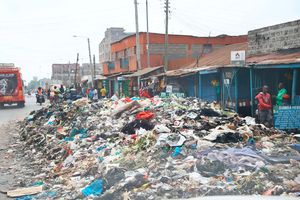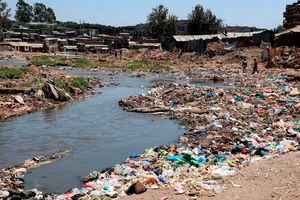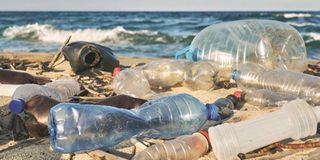
According to UN-Habitat, the greater Nairobi area, with a population of 5.1 million, generates about 3,207 tonnes of waste per day, 20 per cent (641 tonnes) of which is plastic.
Producers have until Monday, May 4, to register with the National Environment Management Authority (NEMA) under Kenya’s new waste law or risk having their products removed from the market.
The registration is a requirement under the Sustainable Waste Management (Extended Producer Responsibility) Regulations, a policy that places full responsibility on producers to manage the waste linked to their products throughout their lifecycle, from manufacturing and packaging to final disposal. In addition to registration, producers must also obtain an annual operating licence from NEMA.
“This deadline was set because the EPR regulation came into force on November 4, 2024, and producers were given six months to comply,” said Dr Ayub Macharia, Director of Environmental Enforcement at NEMA. “Each company must declare its name, the products it introduces into the market, and the volume. Failure to do that, they will be committing an offence.”
The policy, Dr Macharia explained, aims to push companies to rethink their product design, adopt eco-friendly packaging, and invest in sustainable waste management practices. Unlike previous approaches, where a producer’s responsibility often ended once a product reached the consumer, the EPR framework demands end-of-life accountability.
“With EPR, the producer must ensure that once packaging reaches the consumer, it is recovered and recycled. That’s what extended responsibility means,” said Dr Macharia.

Dr Ayub Macharia, Director of Environmental Enforcement at NEMA.
The new law also encourages producers to join collective schemes known as Producer Responsibility Organisations (PROs), which will act on their behalf to recover and manage waste. These schemes are expected to have the technical and financial capacity to execute the obligations, although individual producers may also fulfill the roles independently.
“The purpose of the EPR law is to make Kenya competitive within the region, not to ban products,” Dr Macharia added. “The cost producers will pay to these schemes will make it uneconomical to bring wasteful or over-packaged products. It forces manufacturers to think twice.”
Plastic waste menace
Kenya is grappling with a mounting waste crisis, particularly with plastic waste.
According to the Ministry of Environment, Kenya’s population of 50 million generates about 25,000 tonnes of waste daily—about 0.5 kg per person. Of this, 60 per cent is organic, 30 per cent is recyclable, and 10 per cent is classified as other waste.
A 2022 report by WWF, “Extended producer responsibility for single-use plastics and packaging waste streams: An assessment for Kenya”, described the situation as a “plastic waste emergency,” warning that existing waste infrastructure is inadequate, particularly in rapidly growing urban centres.
Previous interventions—including the 2017 ban on plastic carrier bags and restrictions on single-use plastics in protected areas—were hailed globally as bold steps in the fight against plastic pollution.
However, adherence has been far from smooth, with banned products still finding their way into the country.
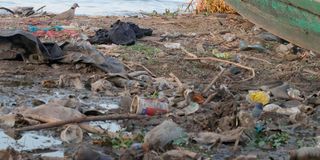
Plastic waste at Koginga Beach in Homa Bay Town on February 18,2025.
The Sustainable Waste Management Act of 2022 places waste management as a devolved function and should be handled within the county's jurisdiction.
Colour-coded system
In February, NEMA introduced a colour-coded system: green for organic waste, blue for recyclables, and black for general waste. Households are expected to begin sorting waste accordingly.
“Eventually, the goal is to reach a point where if you haven’t segregated your waste, it will not be collected,” said Dr Macharia. “It’s about taking personal responsibility.”
Gerphas Opondo, a waste management researcher and the study’s co-author, said the implementation of the EPR must include the informal sector, whom he termed as the first line of defence against plastic pollution. “If informal actors are not integrated into the new system, it will collapse under its weight,” he said. “They are the backbone of plastic recovery in this country.”
For EPR to succeed, experts say the government will need political will, industry buy-in and sustained public engagement. It will also require investment in local capacity, harmonised county policies, and a data-driven approach to track progress.
The EPR regulations define five key waste streams: packaging for non-hazardous products (such as plastics, paper, glass); packaging for hazardous products (such as pesticides and solvents); electronic and electrical waste (like phones and appliances); end-of-life vehicle waste; and non-packaging items.
Registration with NEMA is one step.
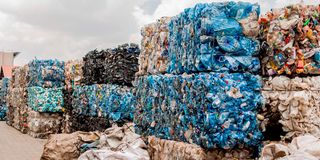
Stacks of plastic waste pictured on September 19, 2023 at Mr Green Africa factory in Nairobi.
Producers must also register with a PRO, declare their volumes monthly, and pay an EPR fee. One area that has generated debate is the flat Sh150 import fee per unit of secondary packaging.
According to Jeremy Kaburu, the circular economy and research specialist, Sustainable Inclusive Business Kenya (the knowledge centre under the Kenya Private Sector Alliance) said that the per-unit fee model could drive up production costs and be passed on to consumers.
“Most businesses recommend shifting from a flat fee per packaging item to a percentage-based levy on the total consignment value. This would be a fairer and more proportional model, where higher-value, higher-risk goods contribute more, while low-value essential goods are protected from punitive costs.”
As the deadline looms, consumer advocacy groups like the Consumers Federation of Kenya (Cofek) have backed the EPR policy. “Producers must take full responsibility for the environmental impact of their products,” said COFEK Secretary-General Stephen Mutoro. He urged NEMA and the Environment Ministry to ensure the law is rolled out fully by May 4.
“The law is here, and it must be implemented,” he said. “We need transparency, fairness, and accountability—but most importantly, we need action.”
Richard Kainika, Secretary-General, Kenya Association of Waste Recyclers: “What we await now is the joint approach, and commissioning expected from the producers. We hope that they won’t be late in engaging our members and that they will engage us in good time. As such, EPR is still a new concept, so we all have a lot of learning along the way,” he said.


